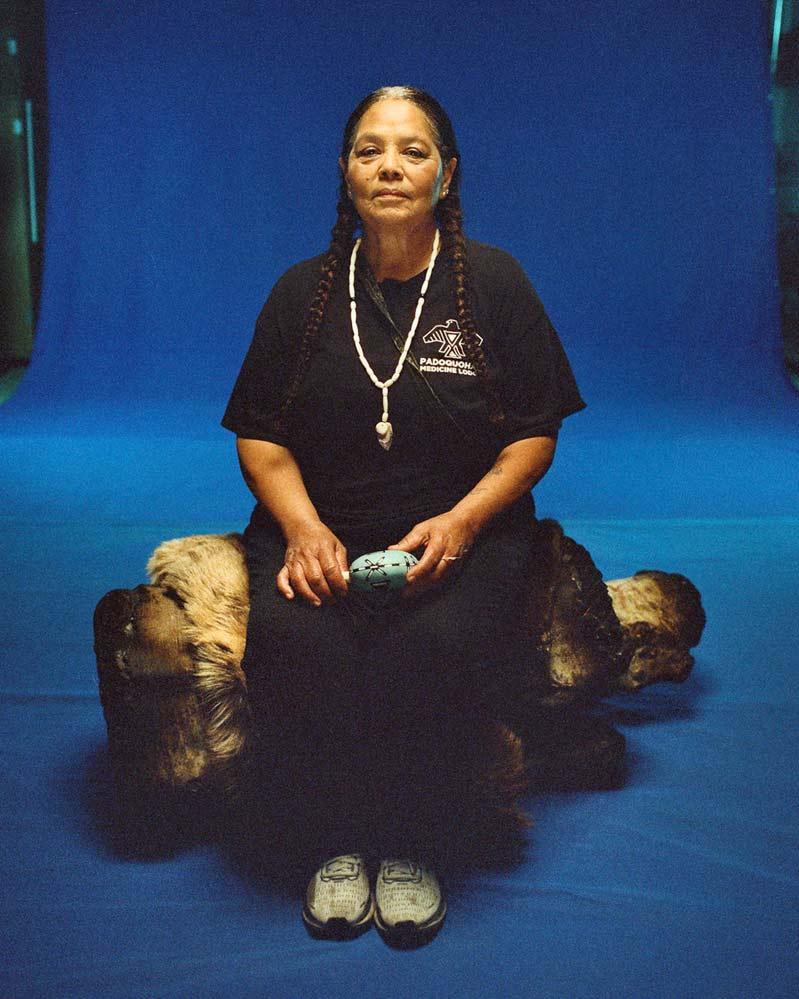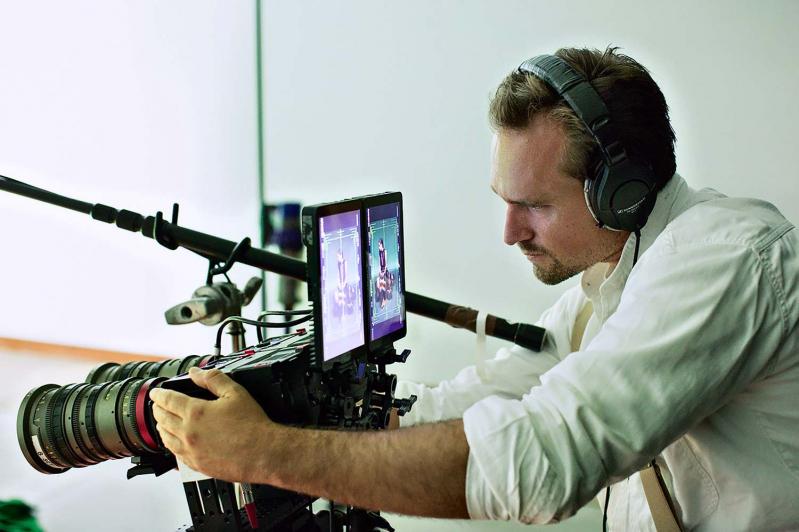It’s appropriate that the installation of the First Literature Project at Guild Hall has the feeling of a sacred space. The lighting is dim. Opposite the gallery entrance is a spotlit area where an actual log draped with a deer hide and otter pelt, and four wooden benches, are arranged on a circle of fresh pine boughs.
“The circle is meant to suggest the edges of a wigwam, a home,” said Christian Scheider, who is co-organizer of the project along with Wunetu Wequai Tarrant, a member of the Shinnecock Nation. “You’re being invited into the storyteller’s home.”
The only thing missing is the storyteller — until you are fitted with the Apple Vision Pro virtual reality headset and invited to sit down. The first oration is by Rebecca Genia, a Shinnecock activist who has fought to protect the tribe’s land and cultural heritage. Hers is a poetic reflection or meditation on the sacred Shinnecock burial ground called Sugar Loaf Hill. As is the case with VR, you feel you are in the same space, and she is close enough to reach out and take your hand.
She is followed by Ms. Tarrant, who, surrounded by stars, clouds, and, at times, land and seascapes, tells her grandmother’s story, “Pawdawe,” in Shinnecock, with English subtitles. “It’s a story people have heard in English over the years. This is the first time we’re hearing it in Shinnecock,” Ms. Tarrant said. “Pawdawe,” too, “tells the story of how we used to do things,” and about sacred places like Sugar Loaf Hill.
As Mr. Scheider pointed out, with VR, unlike film, there are no frame edges. He filmed the speakers with two cameras to create what’s called a stereoscopic VR experience. The technology is such that the viewer is getting two separate images in each eye, which the brain, he said, then converts into “a whole other level of three-dimensionality that’s only achievable in VR.”

But the technology is in service of something pre-technological: face-to-face storytelling. One inspiration of the First Literature Project was the late N. Scott Momaday, an illustrious Native writer. “He had what I like to call a pedagogy of story,” Mr. Scheider said, that maintained that something is no less literary because it’s not written down. “In fact, it might be more literary because somebody decided to remember it.”
“So we talked about what kind of stories would be appropriate to share and enrich understanding of our history,” said Ms. Tarrant, who is working toward her Ph.D. in linguistics at the University of Arizona. “Part of my work is becoming more familiar with the Shinnecock language. Because we don’t have any living fluent speakers, a lot of our work is research-based.”
Mr. Scheider had worked on many projects at Guild Hall with Andrea Grover, its director, and he met with her, as well as with Anthony Madonna, the venue’s director of learning and new works, and Giulia Mascali, its director of grants and donor relations.
While Mr. Madonna felt it was an inspiring project, they all agreed it was an ambitious undertaking. “We had this monumental project and no idea how we were going to do it,” said Mr. Scheider. Then, the week after their discussion, the Creatives Rebuild New York grant was announced.
“It’s like no other grant I’ve ever heard of,” Mr. Scheider said. “It’s a two-year, salaried grant that comes with a living stipend, project support, and resources for the institution.” They applied, and learned after only a month that their proposal would be funded.
There are two other components to the installation. Ms. Tarrant and Mr. Scheider conducted and filmed interviews with members of the Shinnecock Nation. They found that most of those interviewed spoke at length, with virtually no prompting or questioning. Mr. Scheider said it was important to “reverse the anthropological lens so it’s not us coming from the outside to look at you, it’s what you wish to share.”
The other component is Ayim Kutoowonk (She Speaks), a small collective of Shinnecock women committed to learning and promoting the language. Members of the collective recite texts in Shinnecock and then in English, while images related to the texts are projected.
Ms. Tarrant began her involvement with the revitalization of the Shinnecock language as a teaching assistant for her mother, Christina Tarrant, who was a founding member of the Algonquian Language Revitalization Project, which looks at other related dialects.
More recently, she went to the Library of Congress to see its collections, and discovered that specific material on Shinnecock was scarce, and some was missing entirely.
“Our language has never really left us,” she said, pointing out that many place names are intentional. “For example, Amagansett means sweet water. It was a place where travelers would stop to get fresh water. Also, we speak the language in certain capacities, such as ceremonies and songs. That’s how it has persisted in the community.”
“This program comes out of our community artists-in-residence program,” said Mr. Madonna. “It reflects what Andrea has said, that artists lead the way.”
“Anthony was a huge part of this project,” said Mr. Scheider. “Guild Hall is a well-respected institution in our community here, but on Shinnecock it’s not as well known. Since Andrea and Anthony have been here, there have been major strides in that direction. I grew up here, and I know it’s been pretty segregated. At the opening, I had a couple of older women come up to me, and they said they hadn’t been this far east in 30 years. That’s a big deal for what this project means to the community at large. And that’s something I’m really proud of.”
The exhibition will be on view through July 14. Time slots for viewing can be found on the website.
This article has been modified from its original and print versions to include the closing date of the exhibition and a registration link.




